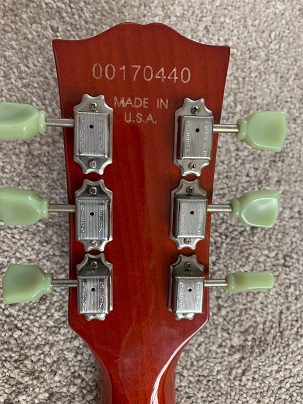Gibson Serial Number Lookup 6 Digit
To verify the authenticity of a Gibson guitar using its serial number, follow these guidelines:
1. 1975-1977: Look for an 8-digit number on a decal at the back of the headstock. The first two digits represent the year (e.g., 99 = 1975, 00 = 1976, 06 = 1977).
2. 1977-Present: The serial number is an 8-digit impression on the headstock with “MADE IN USA” below. Decode it as follows:
- YY: Production year
- DDD: Day of the year
- RRR: Factory ranking/plant designation number
- Prior to 1984, numbers 001-499 indicated Kalamazoo production, and 500-999 indicated Nashville production. Since 1989, all Gibson acoustics are built in Bozeman, MT, and electrics are built in Nashville or Memphis.
3. Les Paul Classic (1989-2014): These models have ink-stamped serial numbers without “MADE IN USA.” Most are 5 to 6 digits long, but early examples have 4 digits. The first digit indicates the year (e.g., 9xxx = 1989, 0xxxx = 1990).
Remember, there are exceptions, so always cross-check with official Gibson resources. If you have a specific serial number, you can use a lookup tool to find detailed information about your guitar.

What is the significance of Gibson serial numbers?
Gibson serial numbers serve as essential identifiers for their guitars. Here’s why they matter:
- Authenticity Verification: Serial numbers help confirm whether a Gibson guitar is genuine or a counterfeit. By decoding the serial, you can determine its production year and factory origin.
- Dating the Guitar: The first few digits reveal the year of manufacture. This information aids collectors, buyers, and enthusiasts in understanding the guitar’s vintage.
- Factory and Model Information: Specific digits within the serial number indicate the factory where the guitar was made (e.g., Kalamazoo or Nashville) and sometimes the model series (e.g., Les Paul, SG, etc.).
- Historical Context: Serial numbers provide insight into Gibson’s production history, changes in manufacturing processes, and shifts in design features over time.
Remember, while serial numbers offer valuable information, exceptions exist, so cross-reference with official Gibson resources for accuracy. 🎸🔍
How do I find the serial number on my Gibson guitar?
The serial number on your Gibson guitar can be found in a couple of places:
- Electric Guitars: Look on the back of the headstock, usually at the top. You’ll find an 8-digit number impressed into the wood, often with “MADE IN USA” below it. This number reveals the production year, day, and factory ranking.
- Acoustic Guitars: Check inside the soundhole sticker or on the neck block. The serial number provides valuable information about your guitar’s history and authenticity.
How can I maintain and care for my Gibson instrument?
Proper maintenance and care are essential for keeping your Gibson guitar in top shape. Here are some tips:
- Regular Cleaning: After playing, wipe down your guitar with a soft cloth to remove sweat, dirt, and oils. Pay attention to the strings, fretboard, and body. Use a dedicated guitar polish or cleaner to maintain its finish.
- String Maintenance: Change your strings regularly to keep them fresh and prevent corrosion. Clean the strings after playing to extend their lifespan.
- Inspect Routinely: Check for loose hardware, cracks, or any signs of wear. Tighten loose screws, nuts, and bolts. Inspect the neck, frets, and bridge for any issues.
- Proper Storage: Store your guitar in a stable environment with consistent temperature and humidity. Use a case or stand to protect it from accidental bumps or falls.
- Tuning: Keep your guitar in tune. Regular tuning ensures proper tension on the neck and prevents unnecessary stress.
- Use and Handling: Be gentle when handling your guitar. Avoid sudden temperature changes, extreme humidity, and direct sunlight.
Remember, a well-maintained Gibson guitar will reward you with beautiful sound and longevity! 🎸🌟